Nav view search
Navigation
Search
Awardee List for the year 1966
| Air Cmde | Krishna Mahesh Agerwala 1648 GD(N) | Unit : -N.A.- | Award Date 26 Jan 66 | Announced 26 Jan 66 | |
| Details : | 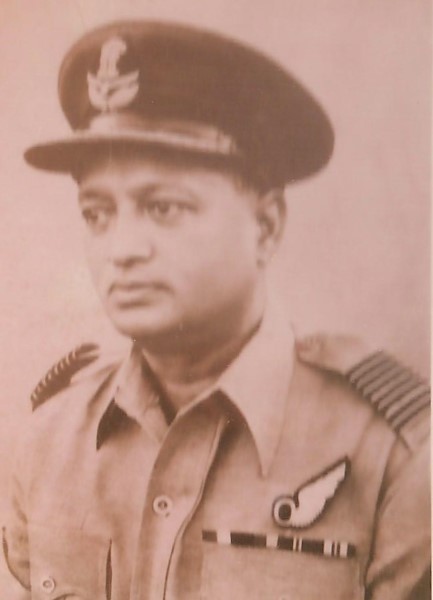 Air Commodore Krishna Mahesh Agerwala has been the Senor Air and Admin. Staff Officer and the Deputy Commander at Headquarters Maintenance Command since June, 1963. Throughout his service career, he has more than ably handled a wide variety of key appointments. In the discharge of his duties he has emerged as an administrator of exceptional ability and caliber. During the period of his tenure, Maintenance Command had to face enormous problems associated with the rapid expansion of the Indian Air Force. As the senior Air and Admin Staff Officer of the Command, Air Commodore Agerwala was responsible for bringing about the administrative coordination necessary for solving the maintenance problems of the Air Force formations and units throughout the country. With his unparalleled devotion to duty, utmost patience and untiring zeal he accomplished this task, thereby maintaining to a considerable degree, the fitness for war of the Air Force formations and units. His achievement in the administrative field during this period was all the more conspi cuous when he had to work under the most adverse circumstances imaginable. With cool, calculated, almost fanatic determination, lea dership and initiative of the most exceptional order, he has been responsible for instilling a spirit of orderliness in various organizational functional aspects of the Command. His effort is all the more creditable because he accomplished this task in spite of and without regard for his personal health, which caused him and his superiors' considerable concern. Air Commodore Agerwala's overall performance over a prolonged period of time, as an administrator, leader of men, organizer and above all, an officer fired with the one and only ambition to give off his very best to the Air Force under all situations will, for ever, remain a shining example of service of the most exceptional order. | ||||
| Reference: | Gazette of India Notification Dated : 26 Jan 1966 Number: | ||||
| Sqn Ldr | Vishwanath Balakrishna Sawardekar 4593 GD(P) | Unit : No.101 Squadron | Award Date 10 Sep 65 | Announced 15 Aug 66 | |
| Details : | 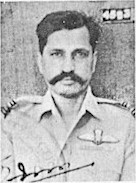 Squadron Leader Vishwanath Balkrishna Sawardekar had been attached to a Fighter reconnaissance squadron for operational duties during the September 1965 operations. On 10th September, 1965, he, along with his copilot, was about to take off on a sortie in a jet trainer, the airfield was suddenly attacked by four Pakistani aircraft as a result of which the trainer aircraft caught fire. Before they could abandon the burning aircraft, the co-pilot’s clothes caught fire; he crawled away from the aircraft but collapsed after removing the top of his burning overall. Sqn. Ldr. Sawardekar received facial injuries. At this stage the ammunition in the aircraft caught fire and began to explode. Without regard for his own safety, Sqn. Ldr. Sawardekar ripped off the remnants of the co-pilot’s overall which was still burning and cut away his burning shoes and socks. He then wrapped his own overall around co-pilot’s body and smothered the flames. He saved the life of his comrade. Squadron Leader Vishwanath Balkrishna Sawardekar displayed exemplary courage and a spirit of comradeship and devotion to duty which are in the best traditions of the Air Force. Other Details: Sqn. Ldr Sawardekar along with Sqn Ldr M J Marston were taxiing in a Vampire Trainer at Bagdogra, when the airfield was attacked by Pakistani Sabres. The Vampire was attacked and it caught fire. Sqn. Ldr Sawardekar jumped out of the burning aircraft and rescued his co-pilot inspite of his own injuries and exploding ammunition. Sqn Ldr Sawardekar elected to help his colleague with utter disregard to his personal safety. | ||||
| Reference: | Gazette of India , 8th October 1966 - No.73 - Pres/66 dated 30th September 1966 | ||||
| Wg Cdr | Krishna Dandapani 3583 GD(P) | Unit : 230 Signal Unit | Award Date 01 Jan 66 | Announced 01 Jan 66 | |
| Details : | 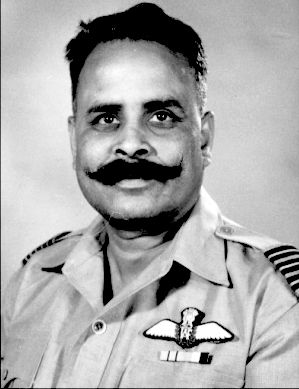 As the Commanding Officer of Signals Unit, located near Amritsar, Wing Commander Krishna Dandapani found himself in the thick of the fight from the moment the original infiltration into Jammu and Kashmir escalated into full-fledged war with the onrush of Pak armour into Chhamb. The only installation which could monitor air activity over Pakistan and the battle area, it became Wg Cdr Dandapani's task to muster the meager resources of men and spares which he had at the time and keep the unit working day and night without any break. He organised his unit to work as a closely knit team and gave timely warnings of Pakistani air intrusions into Indian air space. The Pakistan Air Force, which was fully aware of the immense value of this unit to our Air Force, sent over wave after wave of bombers and fighters by day and by night to bomb and strafe the installation and put it our of commission. Whatever damage was caused to it was immediately repaired and the unit went on the air in a matter of hours. When the original site became known to the enemy and became untenable owing to his raids, Wg Cdr Dandapani and his men moved it under cover of darkness to an alternative site and resumed their work of monitoring the enemy air activities and warning our aircraft of the presence of enemy aircraft in the battle area and their likely intention. Short of competent Controllers, he himself directed our aircraft most of the time to intercept the enemy before he reached our front line positions and warned our fighters of his reinforcements in the air so that they could disengage themselves from the enemy before they were outnumbered. Wing Commander Dandapani's unremitting efforts at keeping the unit serviceable at all times despite the enemy's ceaseless bombing and strafing inspired his colleagues and subordinates to a high pitch of selflessness and efficiency. By his ceaseless efforts, his undiminished enthusiasm and tough moral fibre, he ensured the uninterrupted functioning of the unit which was one of the most valuable parts in our air defence system. | ||||
| Reference: | Gazette of India Notification Dated : 01 Jan 1966 Number: | ||||
| Sqn Ldr | Bawa Prithipal Singh 4051 SIG | Unit : -N.A.- | Award Date 01 Jan 66 | Announced 01 Jan 66 | |
| Details : | 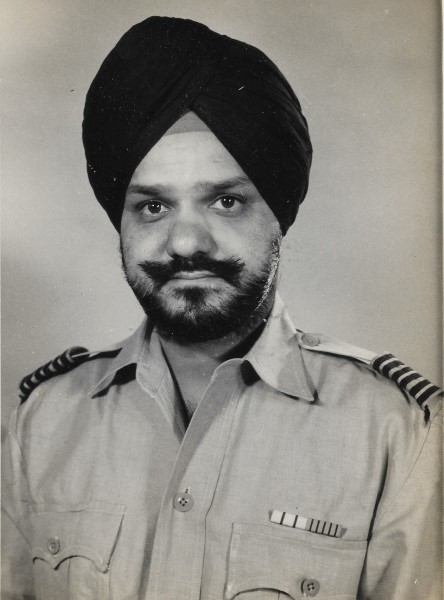 During the Pakistani aggression in September, 1965, a Signals unit commanded by Squadron Leader Bawa Pritpal Singh had been instrumental in giving early warning of enemy air raids in the Jammu region. Despite threats of shelling and many air raids, this signals unit had been functioning round the clock with commendable efficiency. On many occasions this unit alerted Amritsar, Pathankot and Ambala about the approach of enemy aircraft from this area towards them. The unit also alerted the air defence systems when slow moving enemy aircraft were detected flying in this sector. Such enemy aircraft could be expected to drop paratroops in our territory near the vital positions. Through perseverance and personal supervision and guidance Sqn Ldr Singh made it possible to work the old radar equipment of the S.U. for more than 19 hours a day. The vigilance was without any breakdown during the entire period of the operations. The leadership, technical skill and devotion to duty displayed by Sqn Ldr Singh has been of very high order and is in keeping with highest traditions of the Indian Air Force. | ||||
| Reference: | Gazette of India Notification Dated : 01 Jan 1966 Number: | ||||
| Sqn Ldr | Lakhmir Singh 4941 SIG | Unit : 230 Signal Unit | Award Date 01 Jan 66 | Announced 01 Jan 66 | |
| Details : | 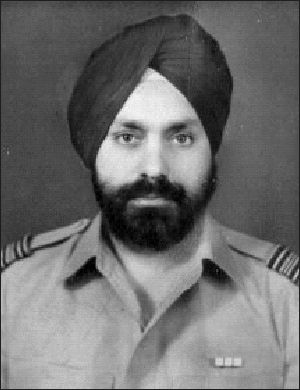 Squadron Leader Lakhmir Singh the Signals officer of one of our radar stations near the IndoÂPak border was charged with the responsibility of maintaining the radar unit at a high state of serviceability. His tasks during the period of operations between 5th August and 23rd September required not only a high degree of technical knowledge but a good deal of resourcefulness and skill at improvisation. His stock of spares was meager; the unit was under constant bombing and strafing attacks by Pakistani bombers and fighters. In one such attack the aerial system was put out of commission. To get another aerial to replace the damaged one would have involved a delay of days, so Sqn Ldr Lakhmir Singh set about repairing the system on the spot which he was able to do in day. The location of the unit having become known, the enemy efforts to destroy it and thus deprive us of our ability to keep track of his activity, increased. To prevent the unit from being permanently put out, Sqn Ldr Lakhmir Singh had to survey another site to which the unit could be moved. The move had to begin and complete at night so that the enemy would be ignorant about its new location and the unit would go on the air again by the morning. This was accomplished and the unit continued to give efficient cover in its new location until cease fire. Throughout the period of operations, Sqn Ldr Lakhmir Singh displayed a high sense of duty, resourcefulness and skill. His ceaseless effort to keep the unit functioning at full efficiency was an example which his subordinate emulated. | ||||
| Reference: | Gazette of India Notification Dated : 01 Jan 1966 Number: | ||||
| Air Cmde | Keki Nadirshah Gocal 1764 GD(P) | Unit : Western Air Command | Award Date 26 Jan 66 | Announced 26 Jan 66 | |
| Details : |  Air Commodore Keki Nadirshah Gocal has been Senior Air Staff, Officer of Headquarters Western Air Command since 30th December 1963. A competent pilot, who is at home in almost all the type of aircraft in that Command, be they fighters, bombers, transport or helicopters, he has applied his knowledge of the aircraft and their performance to good effect in the preparation of operational plans. When hostilities between India and Pakistan broke out, the task of preparing operational plans based on the general directive of Air Headquarters fell on Air Commodore Gocal. Allocation of targets to the fighters, fighter bombers involved a thorough study of the radius of action, take off distance with different war loads in the sharply varying temperatures, the type of weapon appropriate for the destruction of the target, the amount of fuel to be carried with the particular configuration and the sortie profile in respect of the different types of aircraft employed. His duties also involved the coordination of the effort of the technical and armament staff in working out the deployment of squadrons to bases to achieve the best results. Short of hand, Gocal had to work long hours without any rest and be available for advice to the Unit Commanders. He took on all the tasks cheerfully. By making frequent and unscheduled visits to the frontline units during the operations he ensured the smooth functioning and efficient performance of the squadrons. Air Commodore Gocal has set a very good example of selfless dedication to duty and rendered distinguished service of the most exceptional order. | ||||
| Reference: | Gazette of India Notification Dated : 26 Jan 1966 Number: | ||||
| Air Cmde | Victor Srihari 1624 GD(P) | Unit : AFS Jodhpur | Award Date 26 Jan 66 | Announced 26 Jan 66 | |
| Details : | 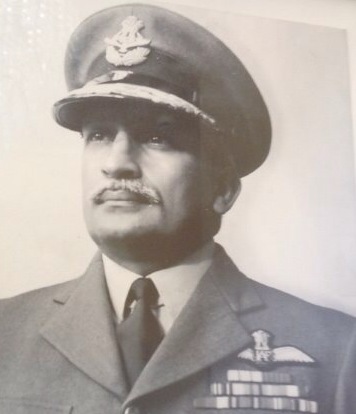 Air Commodore Victor Srihari as the Commandant of the Air force Flying College, Jodhpur was personally responsible for all air operations undertaken from this airfield during the fighting against Pakistan in September, 1965. The Flying College is primarily meant for imparting elementary flying training to various categories of aircrew. The sudden outbreak of hostilities and the enemy air activities in the Rajasthan-Sindh sector posed an unprecedented problem for this Air Officer as his Station had neither the personnel nor the aircraft and equipment to undertake any effective air operations, particularly against aircraft of superior performance of the Pakistani Air Force. In spite of these problems, Air Commodore Srihari rose to the occasion and through constant processes of improvisation and ingenuity organised the basic nucleus of an air defence force to counter the menacing threat from the raiding Pakistani aircraft. Through personal example he encouraged the pilot instructors of the College to readjust themselves to the operational conditions in a very short time and take to the air both by day and night. As the operations progressed, the newly established operational force at Jodhpur under the command of Air Commodore Srihari started flying on missions of a diverse nature. Armed reconnaissance sorties were flown over the battle areas and into the enemy territories for provding vital information so badly required for the operations by the Army in Western Rajasthan. These armed reconnaissance missions were personally planned, controlled and managed by this Air Officer to ensure their utmost effectiveness in the face of superior enemy air potential. Fully aware of the limitation of his force he planned these operations in such manner that the frequent patrols by superior enemy aircraft could not do any effective damage to any our reconnaissance aircraft in this sector. To counter the enemy air raids over Jodhpur and the surrounding areas a fine air defence team was organized by the Air officer and this force contributed to a large extent towards reducing the effectiveness, intensity and accuracy of Pakistani bombing at Jodhpur and the surrounding areas where our army units were operating. This fighter force operated by both day and night although they had very little training for night operations. In the offensive role also, the operational team under this gallant officer inflicted damage on enemy ground targets including some helicopters in spite of very stiff opposition from the enemy. The overall contribution of Air Commodore Victor Srihari towards the air operation in Rajasthan-Sindh sector has been very commendable. | ||||
| Reference: | Gazette of India Notification Dated : 26 Jan 1966 Number: | ||||
| Gp Capt | Bal Bhagwan Marathe 1915 GD(P) | Unit : AFS Agra | Award Date 26 Jan 66 | Announced 26 Jan 66 | |
| Details : | 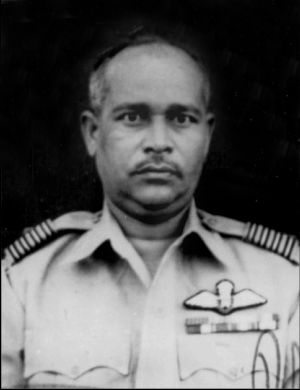 Group Captain Bal Bhagwan Marathe has been in command of one of the major flying Air Force Stations unique for the number, variety and complexity of its lodger units. As the Station Commander, he was faced with enormous problems of timely completion of operation training of the jet bomber crews and transport crews of the Indian Air Force and the abÂinitio and refresher training of the paratroops of the Indian Army. Group Captain Marathe spared neither himself nor those placed under his command in a determined roundÂtheÂclock effort to raise the flying standard of the Wing to an exemplary level of operational efficiency in providing assistance to the units engaged in the logistic support in the J&K area including Ladakh. Faced with enormous problems of acute shortage of trained personnel and equipment, Group Captain Marathe with determination, and able leadership, brought up the operational readiness of the Wing and accomplished the difficult task of training operational aircrew to a high standard of efficiency. Group Captain Marathe's skill and effort as a pilot, his leadership, administrative ability, energy, drive and devotion to duty have inspired his officers and men to an excellent professional standard, by which he has rendered services of an exceptional order. | ||||
| Reference: | Gazette of India Notification Dated : 26 Jan 1966 Number: | ||||
| Gp Capt | Trilok Nath Ghadiok 2354 GD(P) | Unit : AFS Chandigarh | Award Date 26 Jan 66 | Announced 26 Jan 66 | |
| Details : |  In December, 1962, Group Captain Trilok Nath Ghadiok assumed command of a transport wing mainly responsible for the air supply of J&K area including Leh. He set to work with commendable energy and perseverance in the face of numerous difficulties and soon brought the Wing to a high standard of efficiency in the air and on the ground. A pilot of outstanding ability, he has led a number of supply missions to forward areas, setting a very fine example to the experienced aircrew while training juniors. By energizing his men with unremitting care to the utmost effect, he ensured a high rate of aircraft serviceability. By infusing enthusiasm among his officers and men for operational efficiency, he brought the Wing to a high level of cohesive unit and combat-effectiveness. His unflagging zeal, helpful sprit, understanding and integrity have earned him excellent interservice support and coÂoperation and so this Wing has accomplished its large and varying task with unqualified success. The tonnage of supplies and equipment airlifted by this Wing between December, 1962 and May 1965 reached the admirable figure of over 73,000 tonnes. By his devotion to duty and outstanding, effort, Group Captain Ghadiok has rendered service of an exceptional order. | ||||
| Reference: | Gazette of India Notification Dated : 26 Jan 1966 Number: | ||||
| Gp Capt | David Eugene Bouche 2774 GD(P) | Unit : AFS Ambala | Award Date 26 Jan 66 | Announced 26 Jan 66 | |
| Details : | 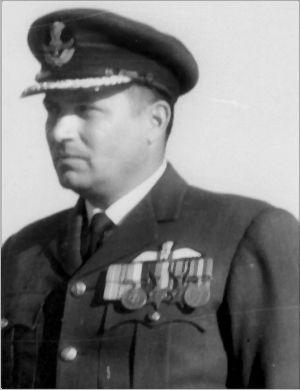 Group Captain David Eugene Bouche assumed command of the Air Force Station, Ambala at the end of January 1965. His Station was responsible for forming and training Gnat Squadrons. All the Gnat units which participated in the recent operations belonged to this station. Within a very short time of the assumption of command, he brought the Squadrons based at his Station to a high pitch of combat effectiveness despite shortages of trained personnel and equipment. An outstanding pilot himself, he imbued his pilots with and offensive spirit. During the recent Indo-Pakistan conflict, when our forward airfields were subjected enemy air attack, Group Captain Bouche organized both day and night air defense properly and used the Gnat aircraft offensively, obtaining good results. He flew many sorties, both during day and night, and himself led a quite a few formations on offensive operations. Group Captain Bouche's outstanding skill as pilot and his leadership in flying, administration and technical preparations produced a very high level of operational effectiveness of the Squadrons based on his station. He has thereby rendered distinguished service of an exceptional order during the recent operations. Group Captain Bouche's outstanding skill as a pilot and his leadership in flying, administration and technical preparations produced a very high level of operational effectiveness of the Squadrons based on his station. He has thereby rendered distinguished service of an exceptional order during the recent operations. | ||||
| Reference: | Gazette of India Notification Dated : 26 Jan 1966 Number: | ||||
| Gp Capt | Surinder Singh 3009 GD(P) | Unit : -N.A.- | Award Date 26 Jan 66 | Announced 26 Jan 66 | |
| Details : |  Group Captain Surinder Singh has been a staff officer in-charge of air operations at Headquarters Western Air Command since 17th July, 1964. A very experienced Canberra pilot and a former Canberra Squadron Commander, he was made responsible for planning bomber operations during the recent campaign. Planning of even training sorties in peace is very time consuming and complex process; planning of bomber operations in war is even more so when factors like enemy anti aircraft and fighter defences, entry into and exit from the enemy area, low level night navigational problems and war load, which are normally not come across in peace, have to be worked out in the minutest detail to ensure successful execution. Throughout the period of operations, Group Captain Surinder Singh worked hard with serious purpose; he not only planned the sorties but briefed the squadron and Flight Commanders personally. The excellent work he turned in is reflected in the unqualified success of our bomber operations. Group Captain Surinder Singh has rendered distinguished service of an exceptional order. | ||||
| Reference: | Gazette of India Notification Dated : 26 Jan 1966 Number: | ||||
| Wg Cdr | Peter Maynard Wilson 3590 GD(P) | Unit : No.16 Squadron | Award Date 21 Sep 65 | Announced 01 Jan 66 | |
| Details : | 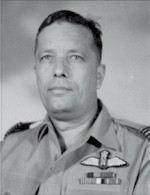 Wing Commander PETER MAYNARD WILSON (3590), General Duties (Pilot) - Wing Commander Peter Maynard Wilson was in command of a bomber squadron. In addition to the bombing raids undertaken at night over various parts ot Pakistan, his squadron was given the task of destroying the high-powered radar station near Badin in the Kutch area. The radar station was heavily defended by all calibres of anti-airciaft guns and it could also call upon its interceptor aircraft to defend it from any air attack. The nature of the target was such that it required extreme accuracy in bombing to achieve satisfactory results. It was, therefore, decided to under-take a low-level bombing raid in broad daylight so that the bomber crew could take full advantage of good visibility and achieve the utmost precision. With full knowledge of the dangers involved. Wing Commander Wilson led his squadron and attacked the radar station with confidence and determination. In spite of very heavy opposition, he and his formation successfully destroyed the radar station which was so vital to the enemy. The courage, leadership and skill displayed by Wing Commander Peter Maynard Wilson on this occasion were in the best traditions of the Air Force. Wing Commander PETER MAYNARD WILSON (3590), General Duties (Pilot) - Wing Commander Peter Maynard Wilson was in command of a bomber squadron. In addition to the bombing raids undertaken at night over various parts ot Pakistan, his squadron was given the task of destroying the high-powered radar station near Badin in the Kutch area. The radar station was heavily defended by all calibres of anti-airciaft guns and it could also call upon its interceptor aircraft to defend it from any air attack. The nature of the target was such that it required extreme accuracy in bombing to achieve satisfactory results. It was, therefore, decided to under-take a low-level bombing raid in broad daylight so that the bomber crew could take full advantage of good visibility and achieve the utmost precision. With full knowledge of the dangers involved. Wing Commander Wilson led his squadron and attacked the radar station with confidence and determination. In spite of very heavy opposition, he and his formation successfully destroyed the radar station which was so vital to the enemy. The courage, leadership and skill displayed by Wing Commander Peter Maynard Wilson on this occasion were in the best traditions of the Air Force. | ||||
| Reference: | Gazette of India , 12th February 1966 - No.15 - Pres/66 dated 1st January 1966 | ||||
| Wg Cdr | Om Prakash Taneja 3843 GD(P) | Unit : No.1 Squadron | Award Date 06 Sep 65 | Announced 01 Jan 66 | |
| Details : | 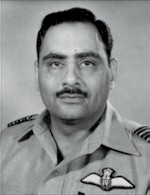 During the operations against Pakistan, Wing Commander Om Parkash Taneja showed inspiring leadership and set a fine example as a Squadron Commander by leading nine strike missions over enemy territory. On 6th September 1965, he led his Squadron for the first mission into enemy territory and destroyed fuel wagons in the Gujranwala sector. On 7th September 1965 he led a formation of 12 aircraft of the Squadron on a dawn strike over Sargodha Airfield. He started up during an air raid warning, when our anti-aircraft guns were firing. Shortly after the air raid he took off from a damaged runway having no runway lights. Through it was still dark, he led his Squadron successfully at low level to the target. On subsequent days he led a number of strike sorties in the Lahore and Sialkot sectors, attacking and destroying enemy tanks, vehicle concentrations and gun and mortar positions in these sectors. By his example he inspired confidence and courage amongst the junior pilots and won the admiration of all serving under him. | ||||
| Reference: | Gazette of India , 12th February 1966 - No.15 - Pres/66 dated 1st January 1966 | ||||
| Wg Cdr | Surapati Bhattacharya 3974 GD(P) | Unit : No.3 Squadron | Award Date 12 Sep 65 | Announced 01 Jan 66 | |
| Details : | 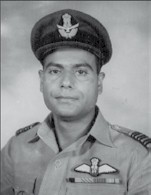 Wing Commander Surapati Bhattacharya was the Flight Commander of an operational fighter squadron in the western sector when the hostilities with Pakistan broke out. He took over the command of the squadron on 12th September 1965. He led a large number of missions against enemy armour and troop concentrations in close support of the army. In the face of enemy ground fire and air opposition, he pressed home his attacks and succeeded in destroying a number of enemy tanks, armoured vehicles and troop concentrations. In every operational mission undertook, he flew as the leader of the formation, and apart from the successes he achieved personally, he contributed to a great extent towards the successes achieved by the other aircraft of these formations. By his personal example, he inspired other officers and airmen and instilled in them a spirit of confidence. Wing Commander Surapati Bhattacharya displayed courage, determination and leadership of a high order in the best traditions of the Air Force. | ||||
| Reference: | Gazette of India , 12th February 1966 - No.15 - Pres/66 dated 1st January 1966 | ||||
| Sqn Ldr | Shri Krishna Singh 3996 ACCT | Unit : AFS Halwara | Award Date 06 Sep 65 | Announced 01 Jan 66 | |
| Details : | 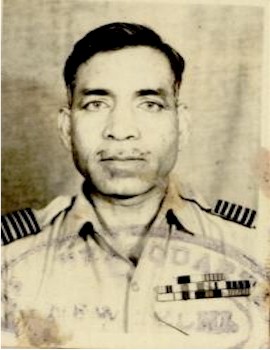 Squadron Leader Shri Krishna Singh was in charge of ground defence and security arrangements of an airfield when hostilities started with Pakistan. On 6th September 1965, over 60 Pakistani paratroopers, equipped with modern weapons and equipment, were air-dropped in the vicinity of the unit to carry out sabotage to our aircraft and installations. Squadron Leader Singh organised a mobile patrol and under his intelligent and able direction, the patrol foiled the enemy’s plan. Finding the airfield defences formidable, the paratroopers finally withdrew from the airfield and were captured by civil and army authorities. On 7th September, 1965, when information was received that some paratroopers had been hiding near a village, Squadron Leader Shri Krishna Singh volunteered to lead a mobile armed patrol to apprehend them. During this operation, he was able to apprehend three paratroopers, including the officer in charge of the Pakistani Para contingent. On an extensive search made under his supervision, 70 parachutes and a considerable quantity of automatic weapons and other equipment were captured. This bold action on the part of Squadron Leader Shri Krishna Singh made the paratroopers attack on the airfields ineffective. | ||||
| Reference: | Gazette of India , 12th February 1966 - No.15 - Pres/66 dated 1st January 1966 | ||||
| Sqn Ldr | Satish Nandan Bansal 4014 GD(N) | Unit : No.5 Squadron | Award Date 14 Sep 65 | Announced 01 Jan 66 | |
| Details : | 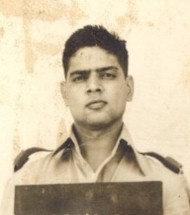 On 13th and 14th September, 1965, a massive bomber raid was mounted against Peshawar airfield, Squadron Leader Satish Nandan Bansal was selected to lead and mark the target. The target was so deep in the heart of enemy territory that the aircraft had to operate from a forward base and to follow a direct route so as to ensure enough fuel for return to base. Though clouds obscure the moon, Squadron Leader Bansal decided to navigate at low level among the hills in order not to disclose the position of the bomber stream. His navigation was so accurate that it needed only one alteration of course to take the aircraft to the centre of the airfield. When he dropped a flare to light up the area, the enemy put up a very heavy curtain of anti-aircraft fire. With courage and determination, he directed the aircraft through the hail of shells and tracers and placed the target-indicating bomb most accurately. In order to compute the bombing index it was necessary to fly over the airfield again. There was no time to climb above the range of guns. Giving no thought to his own safety, Squadron Leader Bansal directed the pilot to fly through the inferno of shells and tracers again and found out the bombing index. This he passed to the bomber leader along with adequate warning to step up the bombing height. But for this some of the bombers might have been shot down. During the operations against Pakistan, Squadron Leader Satish Nandan Bansal was a lead navigator in many bomber attacks. In all his missions, he showed courage and single-mindedness of purpose in the best traditions of the Air Force. | ||||
| Reference: | Gazette of India , 12th February 1966 - No.15 - Pres/66 dated 1st January 1966 | ||||
| Sqn Ldr | Johney William Greene 4093 GD(P) | Unit : No.23 Squadron | Award Date 03 Sep 65 | Announced 01 Jan 66 | |
| Details : | 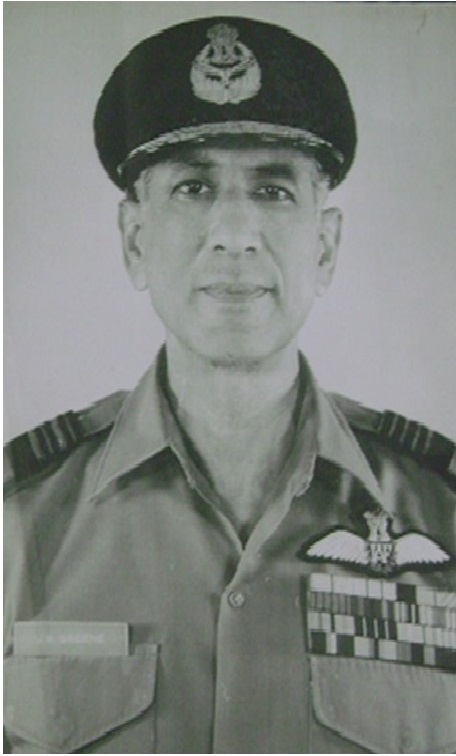 In the initial stages of the operations against Pakistan in the Chhamb Sector, a detachment of Gnat was sent to give cover to our ground attack aircraft and establish our superiority. Squadron Leader Johnny William Greene led missions repeatedly into this sector where the enemy was using missile equipped F-86 Sabre and F-104 Star fighters. He worked out tactics to combat them and, by his personal example and determination, infused confidence in the members of his formation. On 3rd and 4th September 1965, the formations led by him were in the first air combats with the enemy air force. Unmindful of the enemy’s numerical superiority and radar advantage, he controlled and maneuvered his formations with such skill that they succeeded in shooting down two enemy aircraft - the first in these operations. Subsequently, he led a number of formations giving air cover to Mystere and Canberra aircraft in attacks on ground targets. The success of these attacks was largely due to his bravery and leadership. | ||||
| Reference: | Gazette of India , 12th February 1966 - No.15 - Pres/66 dated 1st January 1966 | ||||
| Sqn Ldr | Anthony Louis Mousinho 4418 GD(P) | Unit : No.31 Squadron | Award Date 01 Sep 65 | Announced 01 Jan 66 | |
| Details : | 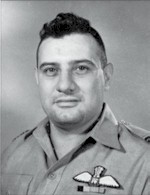 During the recent operations Pakistan, Squadron Leader Anthony Louis Mousinho was the Flight Commander of an Operational Fighter Reconnaissance Squadron. In addition to other operational missions, he led his section of 11 missions against enemy ground positions and pressed home the attacks with courage and determination against a heavy barrage of enemy fire. He undertook dangerous reconnaissance missions in complete disregard of his personal safety. During one such mission he successfully located a tank train, which was subsequently attacked by our aircraft, resulting in 25 Patton tanks being knocked out. His exemplary courage and determination have inspired the men under his command to a high sense of devotion to duty. | ||||
| Reference: | Gazette of India , 12th February 1966 - No.15 - Pres/66 dated 1st January 1966 | ||||
| Sqn Ldr | Sudesh Kumar Dahar 4425 GD(P) | Unit : No.45 Squadron | Award Date 01 Sep 65 | Announced 01 Jan 66 | |
| Details : | 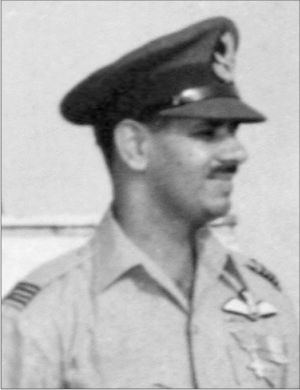 Squadron Leader Sudesh Kumar Dahar was the leader of a Vampire force, which went in action on 1st September 1965 in the Chhamb sector, where a Pakistani force had crossed the border and attacked our positions with heavy armour. Squadron Leader Dahar led the first section, which destroyed six enemy Patton tanks, one anti-aircraft gun position, several trucks and many enemy troops in that area. His section of four Vampire aircraft was attacked by anti-aircraft guns and also by Sabre jets. Skillfully handing the situation, he brought three aircraft safely back to base after a successful mission. His complete disregard of his personal safety was a source of inspiration to the other pilots and his squadron continued to inflict crushing blows on the enemy, destroying enemy supply lines petrol dumps railway wagons, conveys and encampments. The courage and determination displayed by Squadron Leader Sudesh Kumar Dahar were in the highest traditions of the Air Force. | ||||
| Reference: | Gazette of India , 12th February 1966 - No.15 - Pres/66 dated 1st January 1966 | ||||
| Sqn Ldr | Jasbeer Singh 4476 GD(P) | Unit : No.3 Squadron | Award Date 07 Sep 65 | Announced 01 Jan 66 | |
| Details : | 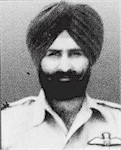 Squadron Leader Jasbeer Singh was serving as a Flight Commander in a fighter squadron operating in the western sector during the operations against Pakistan. On 7th September, 1965, Squadron Leader Jasbeer Singh was detailed as the leader of a strike mission against a high-powered Pakistani radar unit near the Gujranwala airfield, which was greatly hampering our air operations. As his formation was about to attack, Squadron Leader Jasbeer Singh observed four enemy Sabre jets approaching. He immediately warned the formation and undaunted by the interception by the enemy aircraft of superior performance and the intense ground fire, he pressed home his attack and inflicted severe damage on the radar Station. In his final attack, when he had to approach the target very low, his aircraft was hit by ground fire and was seen crashing near the target. In this action, Squadron Leader Jasbeer Singh displayed great valour and unflinching devotion to duty, which were in the finest traditions of the Air Force. | ||||
| Reference: | Gazette of India , 12th February 1966 - No.15 - Pres/66 dated 1st January 1966 | ||||
| Sqn Ldr | Bhupendra Kumar Bishnoi 4594 GD(P) | Unit : No.20 Squadron | Award Date 07 Sep 65 | Announced 01 Jan 66 | |
| Details : | 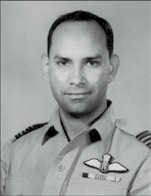 Squadron Leader Bhupendra Kumar Bishnoi arrived at Halwara on 7th September, 1965, for taking part in air operations against Pakistan. Within a period of 15 days, he carried out 16 operational missions of which seven were in close support of the army in the Kasur/Lahore sector. When the enemy ran short o ammunition in the Kasur region Squadron Leader Bishnoi with a formation of four aircraft destroyed a train carrying ammunition at Raiwind Railway Station. The denial of this vital supply was a major factor in causing the enemy to withdraw its armour from this sector with heavy losses. In this other offensive sorties he destroyed or damaged at least ten enemy tanks, armoured vehicles and gun emplacements. Although his aircraft was hit on three different occasions by the enemy ground fire, he pressed home his attacks every time. Throughout these operations, Squadron Leader Bhupendra Kumar Bishnoi displayed courage and leadership in the highest traditions of the Air Force. | ||||
| Reference: | Gazette of India , 12th February 1966 - No.15 - Pres/66 dated 1st January 1966 | ||||
| Sqn Ldr | Chittaranjan Mehta 4615 GD(N) | Unit : No.5 Squadron | Award Date 14 Sep 65 | Announced 01 Jan 66 | |
| Details : | 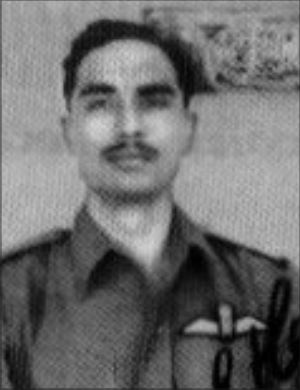 On 14th September 1965, Squadron Leader Chitranjan Mehta was detailed to attack and destroy enemy aircraft and installations at Bhagtanwala. He took off on the night of 14th September, 1965, but half way to the target, all his navigation aids failed. The visibility dropped down to less than one mile and the enemy blackout was so effective that it became impossible to navigate visually. Squadron Leader Mehta immediately took a new route along the river Jhelum. He had to fly very close to a bridge, which was guarded by the enemy with anti-aircraft guns. He skillfully avoided anti-aircraft fire and reached the target. As soon as he reached the airfield, the anti-aircraft guns from Sargodha airfield opened up a heavy barrage on him. To reconnoiter the airfield and to attack the targets, he had to stay over the target for at least 10 minutes. Needless of the anti-aircraft fire and ignoring the risk of being intercepted by missile carrying fighter aircraft that were patrolling a few miles away, Squadron Leader Chitranjan Mehta carried out the reconnaissance successfully. Squadron Leader Chitranjan Mehta carried out nine successful missions and in those he penetrated deep into enemy territory fearlessly by day and by night and inflicted heavy casualties on the enemy. In this mission, Squadron Leader Chitranjan Mehta displayed cool courage, determination and skill of a high order. | ||||
| Reference: | Gazette of India , 12th February 1966 - No.15 - Pres/66 dated 1st January 1966 | ||||
| Sqn Ldr | Sube Singh Malik 4663 GD(P) | Unit : No.7 Squadron | Award Date 06 Sep 65 | Announced 01 Jan 66 | |
| Details : | 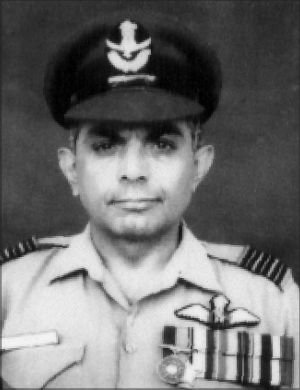 Squadron Leader Sube Singh Malik was engaged in operations against Pakistan as a Flight Commander of a Hunter Squadron. He flew a total of 15 operational missions of which 11 were in close support of the army in the front line. He led formations of Hunter aircraft on offensive air strikes on eight occasions and caused extensive damage and destruction to enemy tanks, vehicles and troops. He pressed home his attacks with determination and courage in spite of heavy enemy ground fire and, on some occasions, enemy interceptor aircraft. On one occasion the control surfaces of his aircraft were damaged but with skill he brought back his aircraft and landed safely at his base. On another occasion he pressed home his attack against a heavily defended target in spite of a warning received from his companion about enemy F-104 aircraft closing in. Undaunted, he completed his task in spite of the heavy odds and brought his formation safely back to base. During another sortie near Harbanspura Railway station, his formation caused extensive damage to enemy armour and gun positions in spite of heavy enemy antiaircraft fire. The courage and tenacity of Squadron Leader Sube Singh Malik were in the highest traditions of the Air Force. | ||||
| Reference: | Gazette of India , 12th February 1966 - No.15 - Pres/66 dated 1st January 1966 | ||||
| Sqn Ldr | Tej Prakash Singh Gill 4755 GD(P) | Unit : No.32 Squadron | Award Date 19 Sep 65 | Announced 01 Jan 66 | |
| Details : | 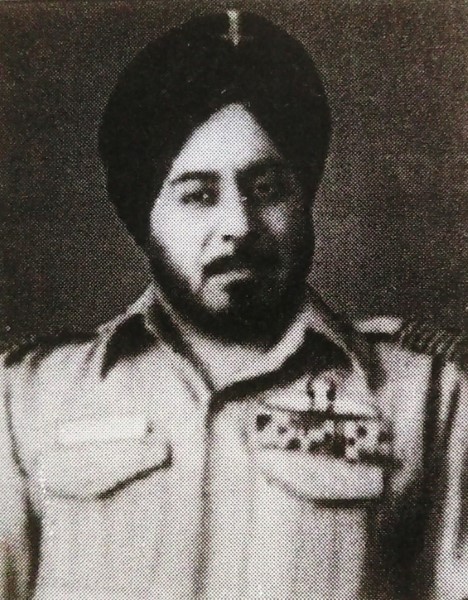 During the operations against Pakistan, Squadron Leader Tej Prakash Singh Gill, the Flight Commander of an Operational Squadron, took part in as many as 21 ground attack missions in support of our ground forces in Sialkot, Chhamb, Lahore and Kasur Sectors. On two such missions on 19th and 21st September, 1965, Squadron Leader T.P.S. Gill encountered a very heavy barrage of anti-aircraft fire. Instead of breaking off the attack squadron Leader Gill pressed it home defiantly in utter disregard of his personal safety and destroyed a considerable amount of enemy armour and field guns. During these missions, Squadron Leader Tej Prakash Singh Gill displayed courage and leadership of a high order. | ||||
| Reference: | Gazette of India , 12th February 1966 - No.15 - Pres/66 dated 1st January 1966 | ||||
| Sqn Ldr | Inder Jeet Singh Parmar 4835 GD(P) | Unit : AFS Jodhpur | Award Date 14 Sep 65 | Announced 01 Jan 66 | |
| Details : | 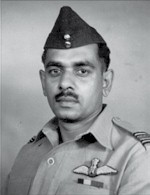 During the operations against Pakistan, Squadron Leader Inder Jeet Singh Parmar carried out sixteen operational sorties out of which seven were low-level reconnaissance missions over enemy concentrations. During these missions, he operated at the extreme limits of the aircraft’s radius of action, very often under enemy anti-aircraft and medium machine gun fire. In one of the sorties, he inflicted heavy damage to an enemy helicopter on the ground. He also carried out nine night air patrols. On the night 14th September 1965 he flew four combat sorties in quick succession after having done a tactical reconnaissance sortie in the afternoon. Single-handed, he succeeded in obstructing enemy bomber and putting them off their bombing aim on our airfield and vital radar installations. In two cases, he chased the enemy bombers away, before they could drop their bombs. In these operations, Squadron Leader Inder Jeet Singh Parmar displayed commendable courage and remarkable flying skill. | ||||
| Reference: | Gazette of India , 19th February 1966 - No.24 - Pres/66 dated 26th January 1966 | ||||
| Sqn Ldr | Ajit Singh Lamba 4877 GD(P) | Unit : No.7 Squadron | Award Date 06 Sep 65 | Announced 01 Jan 66 | |
| Details : | 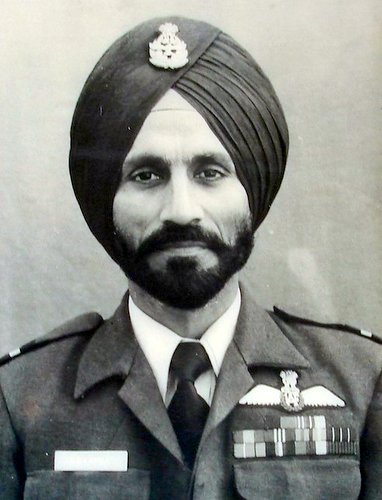 As a Hunter pilot, Squadron Leader Ajit Singh Lamba flew a total of 15 operational sorties, of which 11 were in close support of the army in the Kasur and Lahore sectors. On several of these missions he led formations of Hunter aircraft. He showed great skill and determination in seeking out enemy targets and pressing home his attacks in spite of intensive ground fire and the presence of enemy interceptor aircraft. In spite of heavy opposition, he successfully destroyed several enemy tanks and vehicles. His achievement in the destruction of enemy guns and armour near Harbanspura railway station was specially noteworthy because of the heavy defences surrounding these locations. Throughout the operations Squadron Leader Ajit Singh Lamba showed a marked keenness for action and was always an immediate and ready volunteer for any mission. His courage and devotion to duty inspired other pilots and are in the finest traditions of the Air Force. | ||||
| Reference: | Gazette of India , 12th February 1966 - No.15 - Pres/66 dated 1st January 1966 | ||||
| Sqn Ldr | Pramod Chandra Chopra 5194 GD(P) | Unit : No.8 Squadron | Award Date 11 Sep 65 | Announced 01 Jan 66 | |
| Details : | 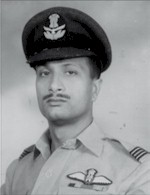 During the recent operations against Pakistan, Flight Lieutenant Pramod Chandra Chopra carried out 14 operational missions and displayed commendable enthusiasm in hunting for the enemy in the sky. On 11th September, 1965, Flight Lieutenant Chopra flew as No. 3 in a four aircraft formation of Mystere on a ground attack strike mission. The formation encountered heavy and concentrated enemy ground fire. Defying the barrage of antiaircraft fire, Flight Lieutenant Pramod Chandra Chopra pressed home his attack and destroyed two enemy tanks in addition to several gun emplacements and vehicles. His courage and determination, which inspired other pilots, were in the best traditions of the Indian Air Force. | ||||
| Reference: | Gazette of India , 12th February 1966 - No.15 - Pres/66 dated 1st January 1966 | ||||
| Flt Lt | Dil Mohan Singh Kahai 5272 GD(P) | Unit : No.1 Squadron | Award Date 07 Sep 65 | Announced 01 Jan 66 | |
| Details : | 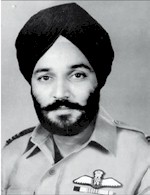 Flight Lieutenant Dil Mohan Singh Kahai was the deputy leader of a Mystere formation, which carried out a daring daylight raid on the very heavily defended Sargodha airfield on 7th September 1965. Despite the intense anti-aircraft fire, he dropped his bombs on four parked aircraft (one F-104 and three F-86) on the Operational Readiness Platform. Then he straffed two more F-86 aircraft and one more F-104 parked on the other Operational Readiness Platform. On 11th September 1965, he flew as No. 2 in a two-aircraft bombing mission over artillery bunkers in the Lahore sector. The bombs dropped by him exploded directly over the bunkers and they were destroyed. On 18th September 1965, flying again as the deputy leader in a four aircraft formation, Flight Lieutenant Kahai scored a direct hit on a gun position near Lahore airfield with rockets and knocked it out. On 19th September, 1965, he led a two aircraft formation and destroyed a Railway Bridge over the Ichhogil canal. The officer also flew a number of strike support missions in which he inflicted damage to enemy equipment and casualties on enemy troops. He also carried out armed patrol sorties near the airfield. The calmness and resolute courage displayed by Flight Lieutenant Dil Mohan Singh Kahai during all these operational missions were a source of inspiration to other pilots and were in the best traditions of the Air Force. | ||||
| Reference: | Gazette of India , 12th February 1966 - No.15 - Pres/66 dated 1st January 1966 | ||||
| Flt Lt | Sharadchandra Naresh Deshpande 5452 GD(N) | Unit : No.5 Squadron | Award Date 06 Sep 65 | Announced 01 Jan 66 | |
| Details : | 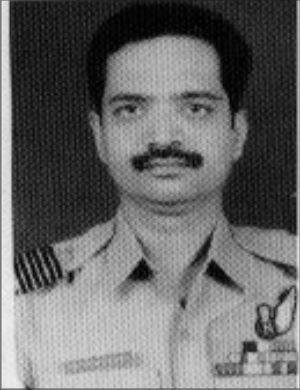 Flight Lieutenant Sharadchandra Naresh Deshpande was serving on the instructional staff of the Jet Bomber Conversion Unit as a navigation instructor when hostilities broke out between India and Pakistan. He volunteered for operational duties and carried out seven operational bombing missions over enemy territory. Flight Lieutenant Deshpande was the navigator/bomb-aimer of the leading aircraft and carried out successful missions in spite of heavy enemy opposition and in total disregard of his own safety. During these bombing operations, he displayed courage, great professional skill and devotion to duty of a high order in the best traditions of the Air Force. | ||||
| Reference: | Gazette of India , 12th February 1966 - No.15 - Pres/66 dated 1st January 1966 | ||||
| Flt Lt | Pradyot Dastidar 5456 GD(N) | Unit : No.5 Squadron | Award Date 15 Sep 65 | Announced 01 Jan 66 | |
| Details : | 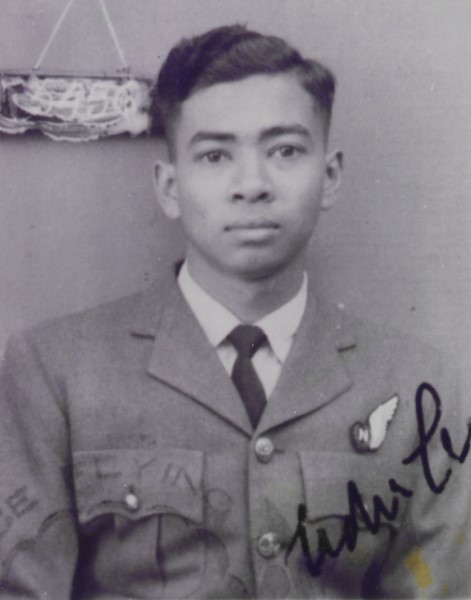 On 15th September 1965, Flight Lieutenant Pradyot Dastidar was detailed as the navigator of a target-marking aircraft to lead a massive attack on Peshawar airfield. This mission was a difficult one and called for the highest skill and accuracy on the part of the navigator. The route passed very near bridges that were defended by the enemy with antiaircraft guns. There was hardly moonlight and the whole area was full of haze. The visibility was so bad that Flight Lieutenant Dastidar saw the airfield only when he was directly overhead. As soon as he dropped a flare to see the target, the anti-aircraft guns opened up a heavy barrage. Undaunted by the shells and tracers he made a steady run and marked the target for the bombing stream coming behind. Then he turned around to see his bomb, while the anti-aircraft guns were firing and shells were bursting around him. After sighting the target-indicating bomb, he passed the bombing index to the leader of the stream. He left the vicinity of the airfield only after he had confirmed that the leader of the stream had received and understood the bombing index. In this mission and in seven other missions, Flight Lieutenant Pradyot Dastidar displayed courage and skill of a high order. | ||||
| Reference: | Gazette of India , 12th February 1966 - No.15 - Pres/66 dated 1st January 1966 | ||||
| Flt Lt | Chandra Sekhar Doraiswami 5601 GD(P) | Unit : No.3 Squadron | Award Date 01 Sep 65 | Announced 01 Jan 66 | |
| Details : | 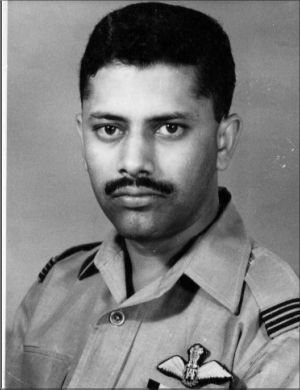 During the operations against Pakistan, Flight Lieutenant Chandra Sekhar Doraiswami took part in 14 operational strike missions against the enemy ground positions. In all his attacks, he displayed great determination inspite of heavy ground fire and enemy air opposition. Twice his aircraft was hit by enemy ground fire and damaged severely. Instead of returning to base, Flight Lieutenant Doraiswami continued on each occasion to press home his attacks in complete disregard of his personal safety and inflicted considerable damage on enemy armour and troops concentrations. Throughout the operations, Flight Lieutenant Chandra Sekhar Doraiswami displayed courage, determination and professional skill of a high order. | ||||
| Reference: | Gazette of India , 12th February 1966 - No.15 - Pres/66 dated 1st January 1966 | ||||
| Flt Lt | Chandra Krishna Kumar Menon 5699 GD(P) | Unit : No.20 Squadron | Award Date 08 Sep 65 | Announced 01 Jan 66 | |
| Details : | 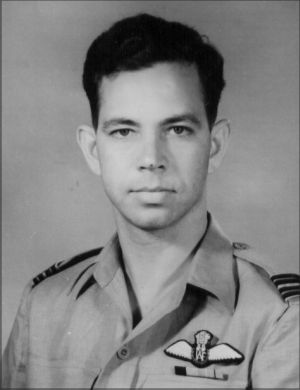 Flight Lieutenant Chandra Krishna Kumar Menon joined a Hunter Squadron at Halwara on 7th September 1965, to take part in operations against Pakistan. By the time the cease-fire came into force he had carried out eight operational sorties of which seven were in close support of the army. On 8th September, 1965, he was detailed to lead a four aircraft formation to engage targets in the Kasur-Lahore sector. His formation destroyed a supply train at Raiwind railway Station. The train was carrying ammunition badly needed by the enemy forces in the Kasur region. The denial of this vital supply of ammunition was a major factor in causing the withdrawal of the enemy armour with heavy losses. During the same mission, a large number of tanks and gun emplacements were also successfully engaged and destroyed or damaged. At least six enemy tanks were destroyed on this occasion. In these sorties, Flight Lieutenant Chandra Krishna Kumar Menon displayed professional skill and utter disregard for his personal safety in the best traditions of the Air Force. | ||||
| Reference: | Gazette of India , 12th February 1966 - No.15 - Pres/66 dated 1st January 1966 | ||||
| Flt Lt | Amarjit Singh Khullar 5854 GD(P) | Unit : No.20 Squadron | Award Date 08 Sep 65 | Announced 01 Jan 66 | |
| Details : | 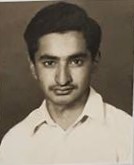 Flight Lieutenant Amarjeet Singh Kullar joined a Hunter Squadron at Halwara on 7th September, 1965, during the operations against Pakistan. Within a fortnight, he carried out eight operational sorties of which seven were in close support of the army. On 8th September, 1965, he flew in a four aircraft formation which destroyed a supply train at Raiwind railway Station. The train was carrying ammunition badly needed by the enemy forces in the Kasur region. The denial of this vital supply was a major factor in causing the withdrawal of enemy armour with very heavy losses. During other operational sorties Flight Lieutenant Kullar destroyed or damaged at least six enemy tanks, armoured vehicles and gun emplacements. He carried out his attacks fearlessly against heavily defended enemy positions and his aircraft was hit by ground fire on three different occasions. Throughout these operations, Flight Lieutenant Amarjeet Singh Kullar displayed courage and leadership in the best traditions of the Air Force. | ||||
| Reference: | Gazette of India , 12th February 1966 - No.15 - Pres/66 dated 1st January 1966 | ||||
| Flt Lt | Vinod Patney 6125 GD(P) | Unit : No.8 Squadron | Award Date 13 Sep 65 | Announced 01 Jan 66 | |
| Details : | 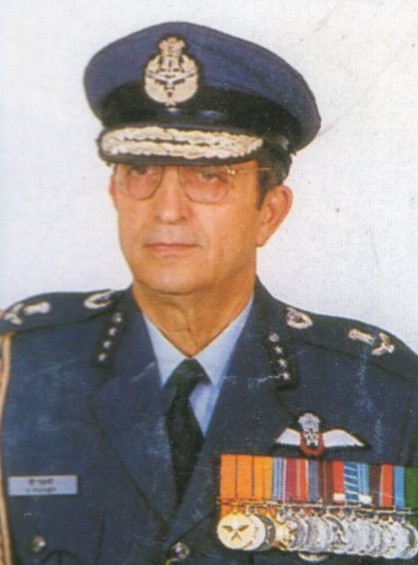 During the operations against Pakistan, Flight Lieutenant Vinod Patney was serving in an Operational Squadron in a forward area. He flew 16 operational sorties within the short period. On 13th September, 1965, he took part in a ground attack mission in the Kasur-Khem Karan Sector and flew as No. 3 in a four aircraft formation. During the attack, the formation met with heavy and determined ground fire from the enemy guns. One of our aircraft was shot down. Undeterred and undaunted by this, Flight Lieutenant Patney pressed home five effective attacks on different enemy targets and destroying 3 Patton tanks. The courage and initiative displayed by Flight Lieutenant Vinod Patney were in the best traditions of the Indian Air Force. | ||||
| Reference: | Gazette of India , 12th February 1966 - No.15 - Pres/66 dated 1st January 1966 | ||||
| Flt Lt | Vinod Kumar Bhatia 6497 GD(P) | Unit : No.8 Squadron | Award Date 08 Sep 65 | Announced 01 Jan 66 | |
| Details : | 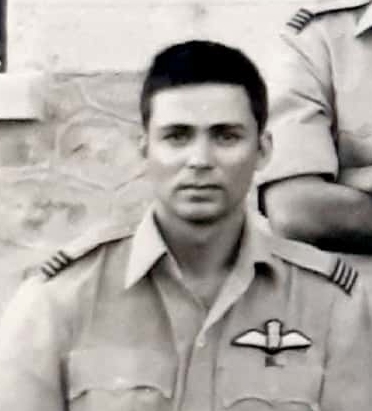 During the operations against Pakistan, Flight Lieutenant Vinod Kumar Bhatia was serving in an Operational Squadron in the Lahore Sector. He flew 18 operational sorties in that Sector. On 8th September, 1965, Flight Lieutenant Bhatia flew as No. 2 in a formation of four Mystere aircraft on a ground attack strike mission. In the face of very heavy and concentrated enemy fire, Flight Lieutenant Bhatia, totally unmindful of the danger, to which he was exposed, pressed home repeated attacks on the enemy tanks and gun positions and destroyed two tanks. The courage and determination displayed by Flight Lieutenant Vinod Kumar Bhatia were in the best traditions of the Indian Air Force. | ||||
| Reference: | Gazette of India , 12th February 1966 - No.15 - Pres/66 dated 1st January 1966 | ||||
| Flt Lt | Gangadhar Ranganath Railkar 5928 GD(N) | Unit : No.106 Squadron | Award Date 22 Sep 65 | Announced 15 Aug 66 | |
| Details : | 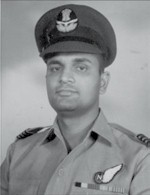 Flight Lieutenant Gangadhar Rangnath Railkar has been a navigator in a Photo Reconnaissance Squadron since 1962. During the September 1965, operations, he undertook several missions and obtained vital information about the enemy dispositions. He always volunteered for the most difficult sorties and flew several operational missions. The valuable information, which he brought by making reconnaissance flights contributed to a large extent towards our planning and successful execution of operations. Throughout, Flight Lieutenant Gangadhar Rangnath Railkar displayed exemplary courage and professional skill of a high order. | ||||
| Reference: | Gazette of India , 8th October 1966 - No.72 - Pres/66 dated 30th September 1966 | ||||
| Flt Lt | Gopal Krishna Garud 6327 GD(N) | Unit : No.106 Squadron | Award Date 22 Sep 65 | Announced 15 Aug 66 | |
| Details : | 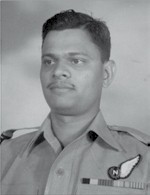 Flight Lieutenant Gopal Krishna Garud has been a navigator in a Photo Reconnaissance Squadron since 1962. Photo reconnaissance flights are fraught with danger as these have invariably to be flown unescorted in broad day light. During the September 1965, operations, he always volunteered for the most difficult missions and brought valuable information which contributed to a large extent towards the planning and successful execution of operations. Throughout, Flight Lieutenant Gopal Krishna Garud displayed exemplary courage and professional skill of a high order. | ||||
| Reference: | Gazette of India , 8th October 1966 - No.72 - Pres/66 dated 30th September 1966 | ||||
| Flt Sgt | Vasudevan Pallavaram 16635 OR | Unit : -N.A.- | Award Date 15 Sep 65 | Announced 01 Jan 66 | |
| Details : | Flight Armourer On the night of 15th /16th September 1965, two aircraft with fuzed bombs in their bomb bays were involved in an accident on the runway of an airfield, as a result of which one of them caught fire. Some of the bombs exploded, others were scattered under the force of explosion and one of them was lodged in a very awkward position in the wing of an aircraft. The scattered bombs were lying on the edge of the runway and one of them had become highly dangerous owing to the heat of the burning wreckage. Normally, Bombs in this condition are demolished on the site, but to have done in this case would have caused further extensive damage. Unmindful of the risk involved, Flight Sergeant Vasudev Pallavaram volunteered to render the bombs safe. He accomplished this task successfully. Thereafter he also recovered the bomb which was lodged in the wing of the aircraft, defuzed it and made it harmless. By his successful accomplishment of this hazardous task, willingly undertaken at grave personal risk, Flight Sergeant Vasudevan Pallavaram displayed cool courage and devotion to duty and set an example to his fellow Airmen. | ||||
| Reference: | Gazette of India , 19th February 1966 - No.25 - Pres/66 dated 26th January 1966 | ||||
| Flt Sgt | Linga Raghaviah 48963 OR | Unit : -N.A.- | Award Date 15 Sep 65 | Announced 01 Jan 66 | |
| Details : | On the night of 15th/16th September 1965, two aircraft with fuzed bombs inside their bomb bay were involved in an accident on the runway of an airfield, as a result of which one of them caught fire. Some of the bombs exploded, others were scattered under the force of explosion and one of them was lodged in a very awkward position in the wing of an aircraft. The scattered bombs were lying on the edge of the runway and one of them had become highly dangerous owing to the heat of the burning wreckage. Normally, a bomb in this condition is demolished on the site, but to have done so in this case would have caused further extensive damage. Unmindful of the risk involved, Flight Sergeant Lingha Ragaviah volunteered to render the bombs safe. He accomplished this task successfully. Thereafter he also recovered the bomb which was lodged in the wing of one of the aircraft, defuzed it and made it harmless. By his successful accomplishment of this hazardous task, willingly undertaken at grave personal risk, Flight Sergeant Lingha Ragaviah displayed cool courage and devotion to duty and set an example to his fellow airmen. | ||||
| Reference: | Gazette of India , 19th February 1966 - No.25 - Pres/66 dated 26th January 1966 | ||||
| Watchman | Amar Singh OR | Unit : AFS Jammu | Award Date 07 Sep 65 | Announced 01 Jan 66 | |
| Details : | Shri Amar Singh was employed by an Air Force Station in Jammu and Kashmir. In August-September, 1965, he moved from village to village and collected vital information about the whereabouts of the infiltrators. On more than one occasion Shri Amar Singh guided army patrols in their operations against the infiltrators. On the 7th September, 1965, when enemy aircraft raided the airfield, Shri Amar Singh rendered valuable service in retrieving arms and ammunition from the burning building in the armoury. Shri Amar Singh displayed commendable courage and devotion to duty. | ||||
| Reference: | Gazette of India , 8th October 1966 - No.74 - Pres/66 dated 30th September 1966 | ||||
| Sqn Ldr | Patrick Russell Earle 3965 GD(P) | Unit : No.1 Squadron | Award Date | Announced 01 Jan 66 | |
| Details : | 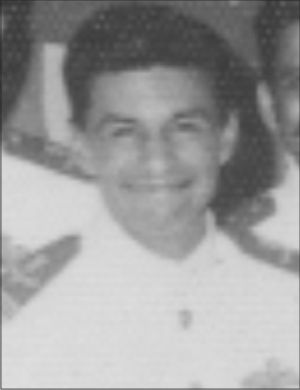 On 10th September, 1965, a formation of Mystere aircraft took off for an operational mission on the western border. When the formation reached the target area, a large numbers of enemy tanks were spotted and intensive barrage of anti-aircraft fire was encountered. Despite a concentrated barrage and against heavy odds, Squadron Leader Patrick Russel Earle led the formation to engage the enemy. When two aircraft of the formation had to abandon the attack because they were too close to turn in, Squadron Leader Earle and his No. 2 orbited at low height to provide cover for the second attack. While doing so, Squadron Leader Earle's aircraft was hit by anti-aircraft fire and there was a hole of about 4 in diameter in the center of the fuselage. The aircraft caught fire and the hole enlarged to about 12 in diameter. Despite this, Squadron Leader Earle did not bale out but brought back the aircraft to base safely, with the fire warning light on all the time. Squadron Leader Patrick Russel Earle displayed courage and professional skill. | ||||
| Reference: | Gazette of India dated 12th February 1966 - No.14-Pres/66 dated 1st January 1966 | ||||
| Sqn Ldr | Arvind Dalaya 4025 GD(P) | Unit : No.114 Helicopter Unit | Award Date | Announced 01 Jan 66 | |
| Details : | 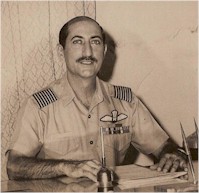 Squadron Leader Arvind Dalaya has been commanding a Helicopter Unit operating in Jammu and Kashmir and Ladakh area since December, 1963. He was given the task of forming a new unit, with only a couple of trained aircrew and technicians. He also had to undertake major commitments in the area, since his was the only Helicopter Unit there. He successfully completed all the commitments assigned to him and also raised the operational standard of the unit. In June, 1964, he was asked to evacuate casualties among members of Nanda Devi expedition. He personally flew the helicopter and successfully evacuated the casualties. In June, 1965, when one of the helicopters of his unit had force-landed at a height of 15,000ft. in the Karakoram mountains, he led a team of technicians to the scene of accident and retrieved the damaged helicopter after changing its engine. During the recent operations against Pakistan in Sialkot sector, he led sorties in the forward areas to bring back our Army battle casualties in spite of enemy aircraft activities in the vicinity. Squadron Leader Arvind Dalaya has set a fine example of leadership and devotion to duty. | ||||
| Reference: | Gazette of India dated 12th February 1966 - No.14-Pres/66 dated 1st January 1966 | ||||
| Sqn Ldr | Bhagat Singh Bakshi 4597 GD(P) | Unit : No.107 Helicopter Unit | Award Date | Announced 01 Jan 66 | |
| Details : | 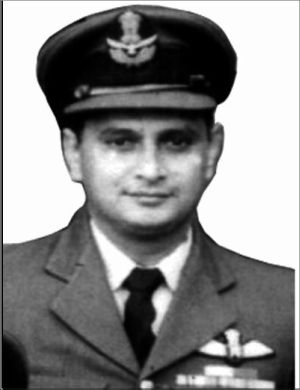 Squadron Leader Bhagat Singh Bakhshi took over as officer in charge of a helicopter detachment drawn from three units. The detachment carried out 567 sorties and flew 433 hours within a period of thirty six days from 18th August, 1965 to 22nd September, 1965. The aircraft operated immediately behind the lines carrying out supply-dropping, bombing and strafing. They evacuated eight hundred and thirty two casualties. They dropped a large number of bombs and fired many rounds of ammunition and conveyed large quantities of ammunition and supplies. This was a vital help to our advancing forces to sustain the newly captured picquets in Jammu and Kashmir. On 31st August, 1965, Squadron Leader Bakhshi carried out three offensive sorties against the infiltrators, flying at low-levels while attacking the targets. He also carried out thirty logistic sorties and thirteen sorties to evacuate the casualties from quickly fabricated helipads within the range of enemy fire. These sorties were flown from an airfield which was under constant threat of enemy air raid without any warning. Undeterred by such grave dangers, the officer accomplished his difficulty tasks with great determination and zeal and displayed a high degree of professional skill and ability which were in the best traditions of the Indian Air Force. | ||||
| Reference: | Gazette of India dated 12th February 1966 - No.14-Pres/66 dated 1st January 1966 | ||||
| Sqn Ldr | Kailash Chandra Khanna 4722 GD(P) | Unit : No.18 Squadron | Award Date | Announced 01 Jan 66 | |
| Details : |  On 10th September, 1965, Squadron Leader Kailash Chander Khanna took off from Halwara as No. 4 in a formation of four Gnat aircraft to provide air cover to two Canberra sections on a bombing mission in enemy territory. All went according to plan and first Canberra was escorted to its target in the Kasur area and brought back safely. A rendezvous with the second section was made the four Gnats again proceeded to the target area. As the two Canberra dropped their bombs, two enemy aircraft were reported. Just then Squadron Leader Khanna noticed that there was malfunction in the fuel system and his low level fuel warning light indicated that, at the height and speed, at which he was flying, he had little over 3 minutes fuel in the aircraft. The nearest landing ground was nearly eighty miles away. Not wishing to divide the formation leader's attention between protection of Canberra and his own emergency, Squadron Leader Khanna decided not to inform the leader of his plight. Only when the Canberras had been escorted to the safety of own territory did Squadron Leader Khanna call out his emergency. He then took a timely and bold decision to gain altitude and switch off the engine to conserve the remaining fuel. Thereafter, he glided towards Halwara and re-lighted the engine of circuit. As he was turning finals to land, his engine flamed out for lack of fuel but he carried out a successful landing. Squadron Leader Kailash Chander Khanna displayed a sense of duty and discipline which were in the best traditions of the Indian Air Force. | ||||
| Reference: | Gazette of India dated 12th February 1966 - No.14-Pres/66 dated 1st January 1966 | ||||
| Flt Lt | Wishnu Mitter Sondhi 5705 GD(P) | Unit : No.220 Squadron | Award Date | Announced 01 Jan 66 | |
| Details : | In September, 1965, Flight Lieutenant Wishnu Mitter Sondhi was sub-section leader in the second formation of Vampires that struck the enemy in the armour in Chhamb Sector. Fully aware that the first section was jumped by an enemy F-86 formation, he kept a sharp look out for the enemy aircraft even when attacking the enemy armour with rockets. Undaunted by the presence of the enemy aircraft of superior performance, he delivered his rockets against the enemy tanks. He sighted a formation of F-86 and registered several hits on it. Meanwhile his wingman warned him of other F-86s closing in astern and Flight Lieutenant Wishnu Mitter Sondhi had to break off to avoid being hit. His wingman was shot down and he alone of his section fought his way back to base. His cool courage and flying skills were in the best traditions of the Air Force. | ||||
| Reference: | Gazette of India dated 12th February 1966 - No.14-Pres/66 dated 1st January 1966 | ||||
| Flt Lt | John Leo Dwettz 5707 GD(P) | Unit : No.111 Helicopter Unit | Award Date | Announced 01 Jan 66 | |
| Details : | 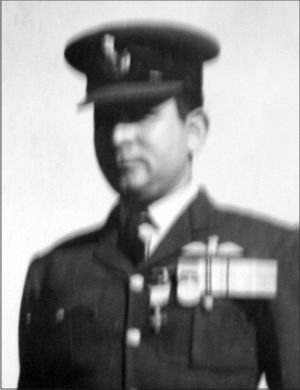 During the operation against Pakistan, Flight Lieutenant John Leo Dweltz, Flight Commander of a Helicopter Unit, flew twenty five offensive, thirty six logistic, twelve casualty evacuation and four reconnaissance sorties within a period of thirty six days. He operated from improvised helipads in difficult terrain with utter disregard to his personal safety. By casualty evacuation, he saved many valuable lives. His supply dropping missions helped to maintain newly occupied picquets. He continued to operate form helipads within the enemy's shelling range and under constant threat of enemy air raids on his airfield without warning. On 11th September, 1965, Flight Lieutenant Dweltz was detailed to attack a strong hold of infiltrators at Raman Nallah. While he was bombing and strafing the enemy bunkers in a narrow valley, the infiltrators started firing at his aircraft with small arm fire. Undeterred by the enemy fire, he carried out his mission with determination. On 15th September, 1965, the army report ed strong enemy pressure on some of our posts in Tithwal area and wanted the Air Force to destroy a rope bridge over the Kishan Ganga. The bridge ran through a narrow valley and the area was occupied by Pakistani infiltrators. Flight Lieutenant Dweltz made three runs over the bridge and dropped forty eight bombs on the target. He set fire to both ends of the bridge and caused damage to its center portion, thus severing the lines of communication of the enemy and relieving pressure on the picquets. | ||||
| Reference: | Gazette of India dated 12th February 1966 - No.14-Pres/66 dated 1st January 1966 | ||||
| Fg Offr | Amerjit Singh Gill 6147 GD(P) | Unit : No.23 Squadron | Award Date | Announced 01 Jan 66 | |
| Details : | Flying Officer Amarjit Singh Gill was one of a small number of pilots who were sent into Chhamb sector to provide air cover to our troops and establish air superiority. Unmindful of personal safety, he flew repeated missions in the area and engaged the enemy on a number of occasions. On 3rd September, 1965, he was engaged by Pakistani Sabres and a F-104, which fired air-to-air missiles. | ||||
| Reference: | Gazette of India dated 12th February 1966 - No.14-Pres/66 dated 1st January 1966 | ||||
| Flt Lt | Subhash Madanmohan Hundiwala 6351 GD(P) | Unit : No.114 Helicopter Unit | Award Date | Announced 01 Jan 66 | |
| Details : | Flight Lieutenant Subhash Madanmohan Hundiwala has been a helicopter pilot in Ladakh since November, 1963. Since then he has flown 430 hours on operational sorties in that area. In spite of hazards of flying over difficult and mountainous terrain of Ladakh, he has always volunteered for difficult missions allotted to the unit. On 18th May, 1965, Flight Lieutenant Hundiwala undertook four sorties in adverse weather conditions to evacuate Army casualties from Kargil. On 28th May, 1965, while on a sortie to evacuate a serious casualty from a place in the Karakoram ranges, he experienced an engine flame out of the engine; yet skillfully handling the helicopter, he successfully carried out a force landing on a helipad located at a height of 15,000 feet. Throughout the tenure of his duties in Ladakh, this officer has carried out difficult missions assigned to him and has displayed courage, professional skill and devotion to duty which are in the best traditions of the Indian Air Force. | ||||
| Reference: | Gazette of India dated 12th February 1966 - No.14-Pres/66 dated 1st January 1966 | ||||
| Flt Lt | Lalit Kumar Datta 6506 GD(P) | Unit : No.111 Helicopter Unit | Award Date | Announced 01 Jan 66 | |
| Details : | 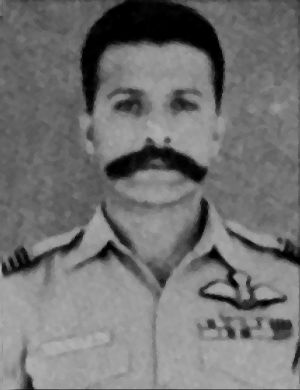 During the operations against Pakistan, Flight Lieutenant Lalit Kumar Dutta, a senior pilot of a Helicopter Unit, carried out eighty one sorties and flew fifty seven hours under very adverse conditions and from quickly improvised helipads, just behind our advancing troops and within the range of enemy's small arms fire. At a great personal risk, Flight Lieutenant Lalit Kumar Dutta carried out eighteen offensive sorties, bombing and straffing strongholds of infiltrators effectively. He flew twenty five sorties evacuating sick and wounded soldiers, thus many saving valuable lives. He also flew thirty sorties to convey ammunition and essential supplies for sustaining the forward picquets. He operated from an airfield which was under constant threat of enemy air raids without warning. Flight Lieutenant Lalit Kumar Dutta has displayed a great sense of responsibility, courage and devotion to duty which are in the best tradition of the Indian Air Force. | ||||
| Reference: | Gazette of India dated 12th February 1966 - No.14-Pres/66 dated 1st January 1966 | ||||
| Flt Lt | Ranjit Kumar Malhotra 6513 GD(P) | Unit : No.114 Helicopter Unit | Award Date | Announced 01 Jan 66 | |
| Details : | 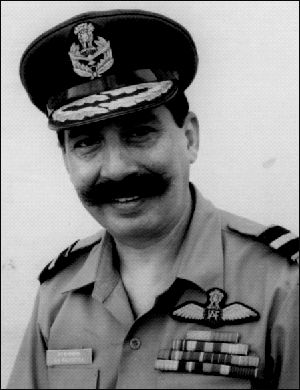 Flight Lieutenant Ranjit Kumar Malhotra has been flying Aloutte III Helicopters in Ladakh since June 1964 and has flown about 400 hours in Ladakh and other areas of Jammu and Kashmir. Despite difficult and mountainous terrain he has always volunteered for difficult operational missions and set a fine example to his colleagues. In May and June, 1965, in adverse weather conditions, he undertook twelve sorties to Kargil for the purpose of evacuating army casualties. Again on 14th August, 1965, he undertook two sorties to evacuate army battle casualties from Naugam in Srinagar valley. During these sorties, he had to land at a place which was encircled by Pakistani infiltrators. They fired at him after he had landed; but with cool courage and presence of mind, he successfully evacuated the casualties from the encircled area. The courage and devotion displayed by him were in the best traditions of the Indian Air Force. | ||||
| Reference: | Gazette of India dated 12th February 1966 - No.14-Pres/66 dated 1st January 1966 | ||||
